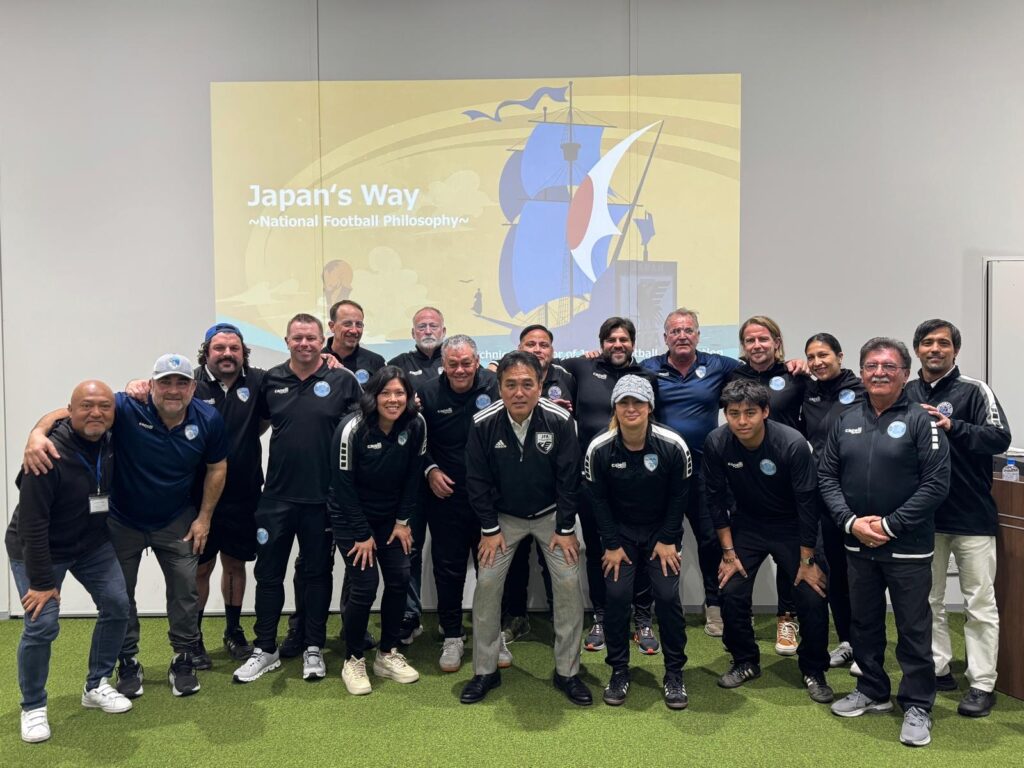Japan Coaching Education Trip: Part 1

If everything goes to plan, Japan will have both hosted and won the FIFA World Cup by 2050, at least according to “Japan’s Way,” a comprehensive planning document the Japanese Football Association created back in 2005.
“To achieve this,” Japan Men’s National Team Technical Director Masanaga Kageyama said, “we must become the happiest country in the world through football.”
Kageyama told this to 16 different coaches and directors from NorCal Premier Soccer who have traveled to Japan to further their coaching education through a series of lectures, training observations, and match analysis.
NorCal Premier Soccer believes that better coaches make better players and therefore partially subsidizes a handful of trips every year to help improve the quality of coaching in Northern California, with the latest taking place over a 12 day period in Japan.
The first few days of the trip took place in Tokyo, and started with a visit to the Japanese Football Association, where Kageyama and JFA Head of Goal-Player Project, Noriyuki Kawamata each gave two hour presentations on their vision for the future of football in Japan.
One of Kageyama’s main talking points revolved around the aforementioned joy of playing the sport, something he felt can often be lost with youth players who don’t have the right environment to develop in.
He recalled memories of parents crying when their children lost in the final games of their youth careers, upset that the kids would now “have to retire.”
“I said, ‘retire?’” Kageyama said. “Why? They are still just 15-years-old.”
After Kageyama finished preaching the importance of finding joy in the beautiful game, and Kawamata delivered an explanation on the JFA’s methodology behind pushing goalkeepers to act more like an extra field player–called a goalplayer–the 16 coaches hopped on a bus to travel to the other side of the city to watch a youth training in the academy of Kawasaki Frontale.
One of the focuses of said training involved trapping the ball and releasing it, which Frontale believe is one of the foundations of the sport.
“The technical ability from all different ages impressed me and showed me that these skills were learned from a young age,” Sheriffs FC Executive Director Glenn Van Straatum said.” It’s second nature to [the Japanese players we’ve watched].”
The following day, NorCal Premier Soccer visited another club in the greater Tokyo area, Yokohama Marinos, whose home ground hosted the 2002 FIFA World Cup final.
“There are no borders in football,” Academy Director Shinya Tsubokura said in welcoming the contingent from the United States.
It was another reminder of the hospitality, respect, and kindness that’s paramount in Japanese culture and also prevalent in the country’s footballing philosophy.
“We want to make the people who support the club proud of themselves through football,” Tsubokura said. “And we think that these actions are related to having good sportsmanship.”
After Tsubokura concluded his presentation, NorCal viewed an academy training, which began with U10 players working together to lift and move a goal to the other side of the field.
“The discipline, the respect, the way of behavior, and the focus is at a completely different level at all the practices we’ve seen,” Van Straatum said. “We saw kids collectively take the goals, bring them to the field, and put them away. Everything is done collectively and there’s listening and respect. It didn’t matter if it was the recreational kids or the professional academy kids, the behavior was the same. From a coachability perspective, this was huge, because it’s clear that the kids are learning a lot.”
From there, it was time to take in and analyze games over the weekend, starting with a preseason friendly between two university teams in Yokohama on Saturday morning, before attending the opening day of the J1 League for a sellout match between Kawasaki Frontale and Nagoya Grampus.

Sunday brought another match, one attended by more than 54,000 fans between Tokyo Verdy and Shimizu S-Pulse.
“The stadiums were full, but there were a couple of other things that really stood out,” Van Straatum said. “The fans were chanting from beginning to end, which was awesome to see. But also people were respected by players, the fans were bowed to. Whether they won or lost, no one left the stadium and the players went to each side of the stadium to bow to the fans and then went to the locker room. No one left the stadium until then.”












